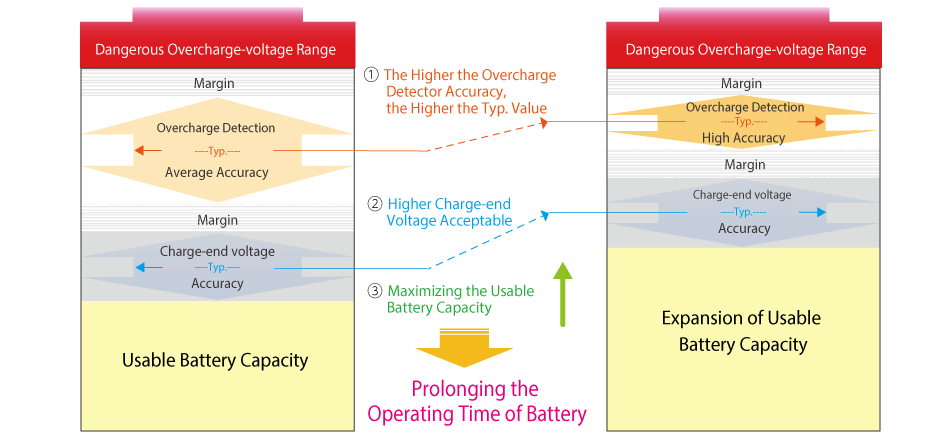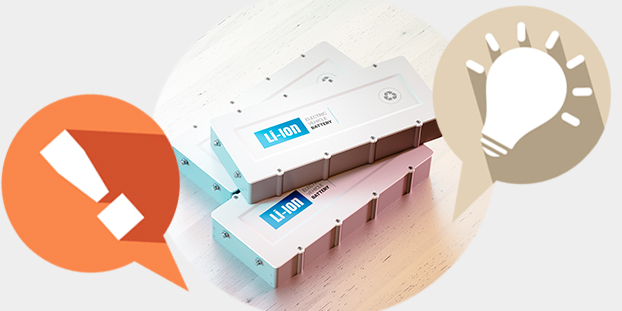Basic Functions and Importance of Detector Accuracy
How should Li-ion batteries be protected in order to prevent deterioration, overheating and fire?
Four Basic Detection Circuits
There are four basic detection circuits inside Li-ion battery protection ICs.
1. Overcharge Detection
The protection prevents battery cells from overcharging.
It cuts off charge current when the cell voltage reaches the overcharge threshold during charging the battery.
2. Overdischarge Detection
The protection prevents battery cells from overdischarging.
It cuts off discharge current when the cell voltage reaches the overdischarge threshold.
3. Discharge Overcurrent Detection
The protection cuts off discharge current when the discharge current reaches the discharge overcurrent threshold.
4. Charge Overcurrent Detection
The protection prevents large current from flowing to the Li-ion battery when charging, for example caused by a malfunctioning charger.
We will explain the features of the protection circuits, the importance of accuracy, and the merits of highly accurate power management ICs.
Overcharge Detection
The overcharge detection is the most important of all the protection circuits for Li-ion batteries.
If a power bank without overcharge detection operates improperly, charging operation will not stop even though the Li-ion battery is overcharged.
The increased cell voltage caused by overcharge distorts the crystal structures of electrodes and deteriorates the battery cells. Serious deterioration not only decreases the product lifetime but also causes dangerous situations such as emitting toxic fumes, fire and even an explosion of the battery.
What are the merits of enhancing the accuracy of overcharge detection?
"Ensuring Safety" and
"Developing Battery Performance to the Maximum"
- Enhancing detector accuracy of overcharge makes it possible to set a higher charge-end voltage.
- High detector accuracy enables the efficient expansion up to the maximum battery capacity.
- The maximum use of the battery capacity contributes to prolonging the operating time of battery.

Enhancement of Charge-end Voltage Achieved by Highly Accurate Overcharge Detector
* The lowest value of the overcharge detector threshold range is higher than the charge-end voltage.
An overcharge detected during charging operation is regarded as charging abnormality, and the operation of the device can be stopped.

In case of one-cell Li-ion batteries, the overcharge protection functions when the battery charger is malfunctioning.
On the other hand, in case of two- or multi-cell batteries (all stand-alone ICs except Analog Front End ICs), the battery charger monitors only the total voltage of the cells connected in series. The overcharge detection by protection ICs is the primary protection. If necessary, an additional secondary protection circuit with a second protection IC must be added.
These days, needs for secondary protection are increasing. In accordance with the increasing requirements, the primary and secondary protection requires different detector thresholds to avoid overlapping. Even in case of secondary protection, voltage settings maximizing the charge capacity are possible by the highly accurate overcharge detection.
Overdischarge Detection
Without overdischarge detection, discharge operation continues, causing deterioration of the battery cells. Serious deterioration not only decreases the product lifetime, but also leads to the impossibility to recharge, where the battery voltage never recovers to normal even after charging operations. The overdischarge detection prevents battery cells from overdischarging by cutting off discharge current.
In general, when the input voltage of the system becomes lower than about 3.0 V to 3.5 V, the system shuts down by itself. The overdischarge detection monitors the decrease of cell voltage by leakage current after shutdown. When the cell voltage becomes lower than the overdischarge threshold, the protection circuit interrupts the output voltage and controls the system to turn to standby mode.

These days, the need for secondary protection is increasing. In accordance with the rising needs, the primary and secondary protections are required to set different detector thresholds to avoid overlapping.Detailed discharge voltage settings are possible by the highly accurate overdischarge detection.
Discharge / Charge Overcurrent Detection
Charge / discharge operation with large currents causes battery overheating and leading to cell deterioration, or destruction of the internal structure of the battery leading to emitting toxic fumes, fire and even explosion.

Why is high accuracy detection required?
As the electronic products consume larger power, it becomes more important to monitor the charge / discharge current with high accuracy to ensure safety.
Reasons for detection with High Accuracy
[Discharge]
- Discharge current is also getting larger year by year as the electronic products consume more energy. However, large-current discharge causes temperature increase of battery cells, leading to battery deterioration or dangerous situations.
- Many standards are being arranged to regulate the amount of currents in electronic devices. (Ex. Limited Power Source Requirements By UL, which limits the maximum output current of through terminals up to 8A)
[Charge]
- The Charge current required by the system is getting larger year by year due to the needs for fast battery charging.
FET SENSE / R SENSE
There are two types of current measurement: FET SENSE and R SENSE. Generally, a voltage difference between both ends of a resistor is used to measure the amount of current. FET SENSE uses the MOSFET on-resistance and R SENSE uses an external resistor.
As soon as Li-ion batteries were adopted in mobile phones, there was no need for an accurate detector because the margins between normal discharge current and the overcurrent detector threshold were large. FET SENSE type current measurement was commonly adopted because the whole system was acceptable. However, R SENSE type current measurement adoption is increasing for today's smartphones and tablet PCs where large current flows require higher detector accuracy more than ever.
By using external resistor sensing, the following products can detect a charge / discharge overcurrent more precisely than conventional solutions using FET on-resistance sensing.
Adopted Products: R5480 Series, R5486 Series, R5494 Series
Nisshinbo Micro Devices contributes to enhancing
“safety and security” of customers’ products.
Industry-Leading "High Accuracy & Low Current Consumption"
Our ICs achieve highly accurate and low supply current characteristics by CMOS analog technology. Small and highly accurate protection ICs facilitate your products to be safer than ever.

Nisshinbo Micro Devices' solutions for “Li-ion battery protection ICs” can assist customers in designing safer products!







